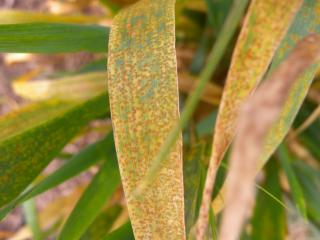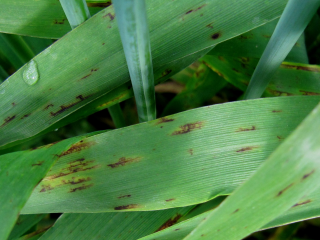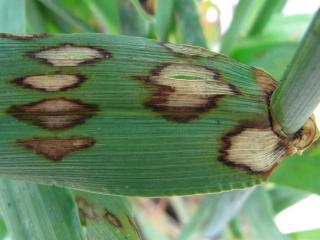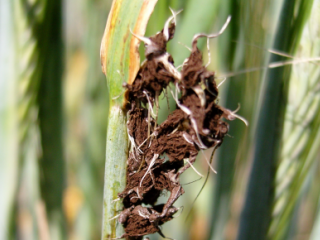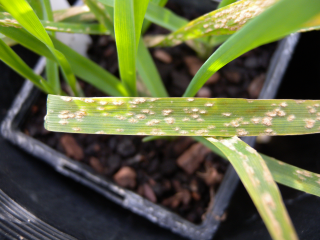A variety of diseases are being found in barley crops
Barley leaf rust, net-type net blotch, scald, loose smut and powdery mildew
- Dandaragan
- Tenterden
- Woogenellup North
- South Stirling
- Kojaneerup South
- Albany
David Cameron (Farmanco) reports finding barley leaf rust (BLR) in a Bass barley crop at Dandaragan. The crop is at growth stage (GS) 41 (ear emergence). The paddock was sown to canola in 2017.
Plant pathologist Kith Jayasena (DPIRD) has reported finding net-type net blotch (NTNB) in Planet barley near Tenterden. The crop was sown on 10 May with Hombre® seed dressing and is at GS 55 (ear emergence). The crop was sprayed with Amistar Xtra® at 400mL/ha on 6 September.
Kith has also reported finding BLR, NTNB, scald and loose smut in a Planet barley crop at Woogenellup North. The crop sown with Systiva® seed treatment and the current GS ranges from 60 (flowering) to 72 (milk development). The crop will be sprayed with Radial® at 420mL/ha.
Kith has found low levels or BLR and loose smut in Rosalind barley at South Stirling. The crop was sown on 28 April with Hombre® seed dressing. The crop is currently at GS 65 (flowering) and was recently sprayed with Aviator Xpro®.
Kith also found scald, possible physiological leaf spotting and hail head damage in a Granger barley crop at South Stirling. The crop was sown on 20 April with Hombre® seed dressing and Uniform® was applied in-furrow. The crop is currently at GS 75 (milk development) and was recently sprayed with Aviator Xpro®.
Powdery mildew has been seen for the first time in Baudin trap plants located in a department trial sites at South Stirling and Kojaneerup South.
BLR is also on Planet barley at the Albany DPIRD office trial site.
Barley leaf rust
BLR develops rapidly in moist conditions when temperatures are between 15-22°C.
The variety Bass is susceptible to very susceptible (SVS) to BLR in the adult growth stages (after flag leaf emergence), while Rosalind and Planet have moderate resistance (MR) and resistance (R) respectively.
Growers and consultants are strongly urged to participate in the Australian cereal rust survey and submit samples to the University of Sydney, Private Bag 4011, Narellan NSW 2567 for pathotype testing if they are finding rusts in crops.
For more information on BLR and how to manage it refer to DPIRD’s Diagnosing barley leaf rust page.
Net-type net blotch
There are different pathotypes of NTNB present in WA. As a consequence varietal response will vary accordingly.
For more information on NTNB and how to manage it refer to DPIRD’s Managing net-type net blotch of barley in Western Australia page and the 2018 PestFax Issue 19 article Both net blotches are being found in barley.
Scald
Granger is susceptible (S) to scald in the adult growth stages, while Planet is rated resistant to moderately resistant (RMR).
For more information on scald refer to DPIRD’s Diagnosing barley scald page.
Loose smut
Barley loose smut is a fungal disease affecting seed heads, which can cause yield losses. In plants grown from infected seed, florets are replaced with a compact mass of dark brown-black powdery spores at heading. These spores are dispersed by wind to infect adjacent plants and produce the next generation of infected seed. Infection is favoured by rainfall and high humidity during flowering. In the paddock look for scattered plants with black heads or bare flower stalks.
For more information refer to the department's Diagnosing barley loose smut page.
Powdery mildew
Baudin is susceptible to very susceptible (SVS) to powdery mildew in its adult growth stages.
For more information on powdery mildew and how to manage it refer to DPIRD’s Management of barley powdery mildew in 2018 page.
Fungicide application information
Fungicide choice needs to take into account the diseases present in a crop. Where a variety is susceptible to both of the diseases present, a fungicide that is registered to control both of them is required. For more fungicide information refer to the department’s Registered foliar fungicides for cereals in Western Australia page.
For more information on barley diseases contact Kithsiri Jayasena, Plant Pathologist, Albany on +61 (0)8 9892 8477, Geoff Thomas, Plant Pathologist, South Perth on +61 (0)8 9368 3262 or Andrea Hills, Plant Pathologist, Esperance on +61 (0)8 9083 1144 or Ciara Beard, Plant Pathologist, Geraldton on +61 (0)8 9956 8504.

